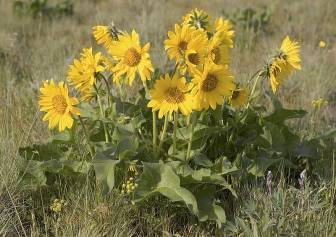SPP Plant Profile: Puget Balsamroot (Balsamorhiza deltoidea)
By Graduate Research Associate Evan Hayduk
Basic Information:
Balsamorhiza deltoidea, or Puget balsamroot, is late spring flowering perennial with showy sunflower like flowers. The distinct leaves of this species are basal, wide, and spear shaped. The flower stems can be up to 3 feet tall, and it is found in open, grassy areas, at low to high elevations from Southern British Columbia to Northern California.
Ecological Importance:
Considered critically imperiled but globally secure in Canada, only eight natural populations containing roughly 1,600 mature plants are thought to remain north of the border. These remaining populations are declining due to development and continued habitat degradation from competition with invasive species. There are 15 reported populations in the state of Washington. Evidence suggests that five of these populations may have been extirpated. A recent study by researchers at the University of Puget Sound* has shown that Puget Balsamroot appears to be incapable of self-pollination, and is dependent on pollinators for reproduction. However, decreases in pollinator species like bumblebees and honey-bee populations and increasing fragmentation and degradation of suitable habitat limits the natural reproduction of this and many other species.
Fun Facts:
Puget balsamroot is well known for its traditional culinary and medicinal uses. This includes its use as chicken feed by early settlers on Vancouver Island, suggesting that it was common in the area during that time period. The roots of Puget balsamroot are edible raw and when cooked have a sweet taste. Young shoots can also be eaten raw, and seeds eaten raw or cooked. The roasted root can be used as a coffee substitute and seeds can be ground into a powder and made into bread. Medicinally, a decoction of the roots was used in the treatment of coughs and colds.
To donate to SPP and support endangered prairie plant conservation, please click here.
*This study can be found at: http://www.bioone.org/doi/full/10.3955/046.085.0220


11 Comments:
Ricardo Nickens
I am surprised to find out that this beautiful, but unfortunately, engangred plant can be used as a substitute for coffee and that it can be cooked, giving natural sweet flavour of the meal. I remember making a bouquet from these for mommy when I was 8 years old…
Moving
day trading earnings
This paragraph is genuinely a fastidious one it assists new net viewers, who are wishing in favor of blogging.
day trading as a business
It’s going to be end of mine day, however before ending I am reading this wonderful post to increase my
experience.
video marketing news
Hello to every body, it’s my first visit of this website; this website carries awesome and really excellent information for visitors.
day trading as a business
That is really attention-grabbing, You’re a very skilled blogger.
I have joined your feed and sit up for searching for extra of your wonderful post.
Also, I have shared your website in my social networks
24 hour hvac repair 18970
If some one wishes to be updated with latest technologies then he must be visit this website and be up to date everyday.
Here is my site: 24 hour hvac repair 18970
day trading entry strategies
Woah! I’m really loving the template/theme of this site.
It’s simple, yet effective. A lot of times it’s hard
to get that “perfect balance” between user friendliness and visual appeal.
I must say you have done a great job with this. Also, the blog loads super quick for me on Chrome.
Exceptional Blog!
metabolic fat factor reviews
Hey I know this is off topic but I was wondering if you knew of any widgets I could
add to my blog that automatically tweet my
newest twitter updates. I’ve been looking for a plug-in like this for quite some time and was hoping maybe you would have some experience with
something like this. Please let me know if you run into anything.
I truly enjoy reading your blog and I look forward to your new updates.
where to buy metabolic fat factor
There’s certainly a great deal to know about this topic.
I love all the points you made.
cellfoods.net
Excellent article. I’m dealing with many of these
issues as well..
Christin
Emilay Breast Enhancement,- Dibuat oleh standart GMP (Good Manufacturing Practices).